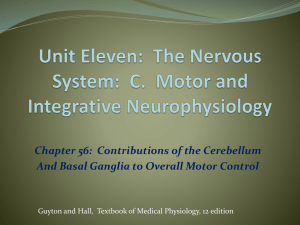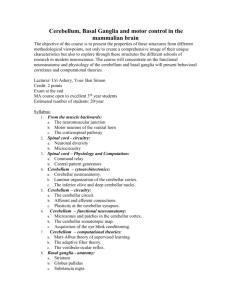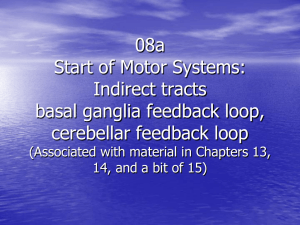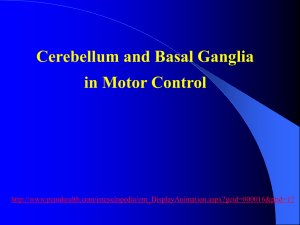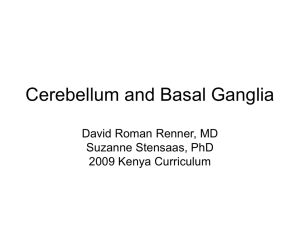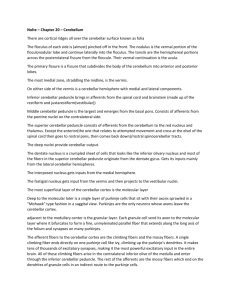Physiology Ch 56 p681-695 [4-25
advertisement
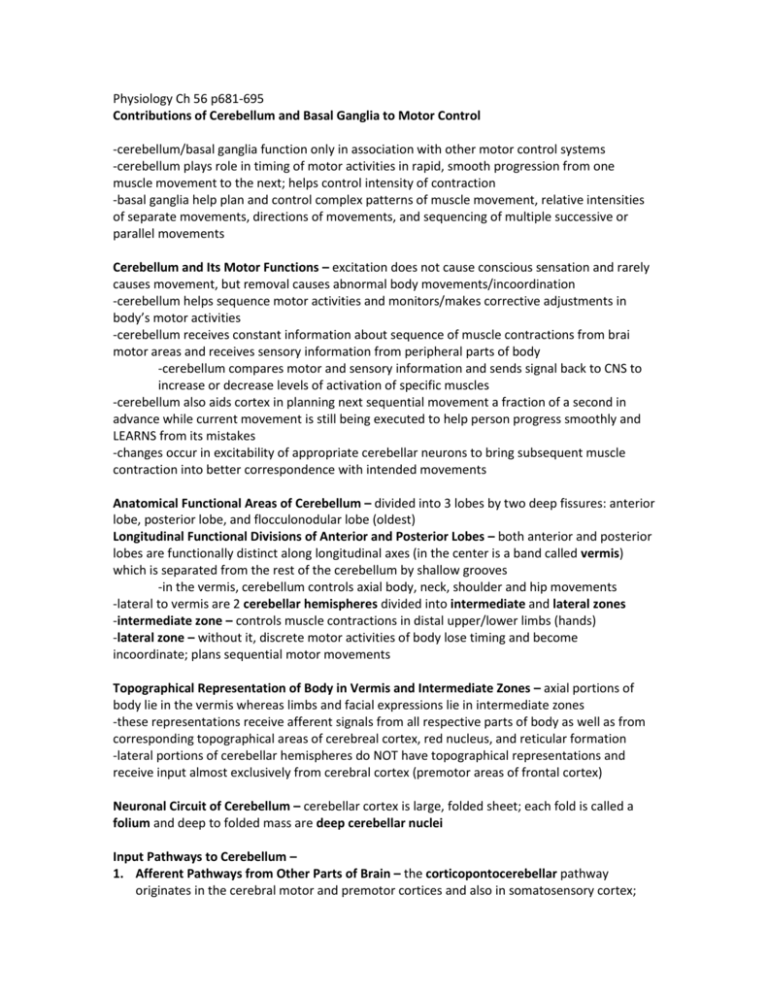
Physiology Ch 56 p681-695 Contributions of Cerebellum and Basal Ganglia to Motor Control -cerebellum/basal ganglia function only in association with other motor control systems -cerebellum plays role in timing of motor activities in rapid, smooth progression from one muscle movement to the next; helps control intensity of contraction -basal ganglia help plan and control complex patterns of muscle movement, relative intensities of separate movements, directions of movements, and sequencing of multiple successive or parallel movements Cerebellum and Its Motor Functions – excitation does not cause conscious sensation and rarely causes movement, but removal causes abnormal body movements/incoordination -cerebellum helps sequence motor activities and monitors/makes corrective adjustments in body’s motor activities -cerebellum receives constant information about sequence of muscle contractions from brai motor areas and receives sensory information from peripheral parts of body -cerebellum compares motor and sensory information and sends signal back to CNS to increase or decrease levels of activation of specific muscles -cerebellum also aids cortex in planning next sequential movement a fraction of a second in advance while current movement is still being executed to help person progress smoothly and LEARNS from its mistakes -changes occur in excitability of appropriate cerebellar neurons to bring subsequent muscle contraction into better correspondence with intended movements Anatomical Functional Areas of Cerebellum – divided into 3 lobes by two deep fissures: anterior lobe, posterior lobe, and flocculonodular lobe (oldest) Longitudinal Functional Divisions of Anterior and Posterior Lobes – both anterior and posterior lobes are functionally distinct along longitudinal axes (in the center is a band called vermis) which is separated from the rest of the cerebellum by shallow grooves -in the vermis, cerebellum controls axial body, neck, shoulder and hip movements -lateral to vermis are 2 cerebellar hemispheres divided into intermediate and lateral zones -intermediate zone – controls muscle contractions in distal upper/lower limbs (hands) -lateral zone – without it, discrete motor activities of body lose timing and become incoordinate; plans sequential motor movements Topographical Representation of Body in Vermis and Intermediate Zones – axial portions of body lie in the vermis whereas limbs and facial expressions lie in intermediate zones -these representations receive afferent signals from all respective parts of body as well as from corresponding topographical areas of cerebreal cortex, red nucleus, and reticular formation -lateral portions of cerebellar hemispheres do NOT have topographical representations and receive input almost exclusively from cerebral cortex (premotor areas of frontal cortex) Neuronal Circuit of Cerebellum – cerebellar cortex is large, folded sheet; each fold is called a folium and deep to folded mass are deep cerebellar nuclei Input Pathways to Cerebellum – 1. Afferent Pathways from Other Parts of Brain – the corticopontocerebellar pathway originates in the cerebral motor and premotor cortices and also in somatosensory cortex; passes through pontile nuclei and pontocerebellar tracts to lateral divisions of cerebellar hemispheres. Afferent tracts also originate from brain stem and include: a. olivocerebellar tract - inferior olive to all parts of cerebellum; excited by fibers from motor cortex, basal ganglia, reticular formation, and spinal cord b. vestibulocerebellar tract – vestibular apparatus focculonodular lobe and fastigial nucleus of cerebellum c. reticulocerebellar tract – originates in brain stem reticular formation and terminates in midline cerebellar areas (vermis) 2. Afferent Pathways from Periphery – 4 tracts from periphery on each side, 2 are dorsally in cord and two are ventral. Most important are the dorsal and ventral spinocerebellar tracts a. Dorsal Spinocerebellar Tract – enters cerebellum through inferior cerebellar puduncle and terminates in vermis and intermediate zones on same side as origin i. Signals come mainly from muscle spindles, but also tendon organ, tactile receptors, and joint receptors ii. Apprise cerebellum of momentary status of muscle contraction, degree of tension, positions and rates of movement, and forces on the body b. Ventral Spinocerebellar Tract – enters cerebellum through superior cerebellar peduncle and terminates on both sides of the cerebellum i. Excited mainly by motor signals from ventral horns of spinal cord from (1) brain through the corticospinal and rubrospinal tracts, and (2) internal motor pattern generators in cord itself ii. Ventral pathway tells cerebellum which motor signals have arrived at anterior horns, called the efference copy of anterior horn motor drive -spinocerebellar pathways can transmit up to 120m/s (fastest in CNS), which is important for instantaneous apprisal of cerebellum of changes in peripheral muscle actions -signals also transmitted from spinal dorsal columns dorsal column nuclei of medulla cerebellum -signals further transmitted through spinoreticular pathways to reticular formation of brain stem and also through spin-olivary pathway to inferior olivary nucleus Output Signals From Cerebellum – Deep Cerebellar Nuclei and Efferent Pathways – on each side of cerebellum exist 3 deep cerebellar nuclei: the dentate, interposed, and fastigial; all deep cerebellar nuclei receive signals from cerebellar cortex and deep sensory afferent tracts to cerebellum -each time signal arrives in cerebellum, it divides and goes to two directions: into deep cerebellar nuclei and the corresponding area of cerebellar cortex overlying deep nucleus -then, cerebellar cortex relays an INHIBITORY signal to deep nucleus – therefore all signals that enter cerebellum eventually end in deep nuclei in the form of initial excitatory signals followed by inhibitory signals -output signals leave cerebellum and are distributed to other parts of brain Major efferent pathways out of cerebellum are: 1. One that originates in vermis and passes through fastigial nuclei medullary + pontile regions of brain stem; functions to control equilibrium and posture 2. One that originates in intermediate zone of cerebellar hemisphere and passes through interposed nucleus ventrolateral/ventroanterior nuclei of thalamus cerebral cortex, several midline structures of thalamus basal ganglia, and the red nucleus/reticular formation of upper brain stem a. Helps coordinate reciprocal contractions of agonist/antagonist muscles 3. Pathway originating in lateral zone of cerebellar hemisphere and passes dentate nucleus next to ventrolateral/ventroanterior nuclei of thalamus cerebral cortex and helps coordinate sequential motor activities initiated by cerebral cortex Functional Unit of Cerebellar Cortex – The Purkinje Cell and Deep Nuclear Cell – there are three layers of the cerebellar cortex: the molecular layer, Purkinje cell layer, and granule cell layer; beneath these, in the center of cerebellar mass are deep cerebellar nuclei Neuronal Circuit of the Function Unit – output from the functional unit is from a deep nuclear cell, which is continually under both excitatory and inhibitory influences -excitatory influence arise from direct connections with afferent fibers entering cerebellum from periphery or from brain stem, and inhibitory influence is entirely from the Purkinje cell in cortex -Afferent inputs to cerebellum are of 2 types: climbing fiber and mossy fiber 1. Climbing Fibers - all originate from inferior olives of medulla (1 fiber to 10 Purkinje cells) -these fibers first send branch to deep nuclear cells, and rises all the way to superficial layers of cerebellar cortex where it makes 300 synapes with soma/dendrites of purkinje cell -single impulse causes a single, prolonged action potential in purkinje cell which is a strong spike followed by trail of weak spikes; this is called the complex spike 2. Mossy Fibers – all other fibers entering cerebellum from brain, brainstem, and spinal cord -these fibers send collaterals to excite deep nuclear cells, but also proceed to granule cell layer of cortex where they synapse with thousands of granule cells -granule cells send small axons to cerebellar cortex and divide into two branches and extend into folia; there are millions of parallel nerve fibers because there are 700 granule cells per 1 Purkinje cell -Purkinje cells project their dendrites and synapse in this parallel fiber layer -mossy fiber input is different from climbing fiber input because connections are so weak, so large numbers of mossy fibers must be stimulated to excite purkinje cell -weaker action potential elicited in Purkinje cell called a simple spike Purkinje Cells and Deep Nuclear Cells Fire Continuously Under Resting Conditions – fire 50-100 action potentials per second (Purkinje) and higher in deep nuclear cells Balance Between Excitation and Inhibition at Deep Cerebellar Nuclei – stimulation of deep nuclear cells by mossy and climbing fibers stimulates them, whereas stimulation by Purkinje cells inhibit them, and excitation is always slightly higher than inhibition -for rapid motor movement, initiating signal from cerebral motor cortex first increases deep nuclear cell excitation, then a feedback inhibitory signal from Purkinje cells occur; so that when a rapid enhancement of motor movement and later inhibition (called dampening) causes muscle not to overshoot Other Inhibitory Cells in the Cerebellum – Basket cells and Stellate cells are inhibitory cells with short axons in the molecular layer of cerebellar cortex and are stimulated by small parallel fibers -they send their axons at right angles across parallel fibers and cause lateral inhibition of adjacent Purkinje cells to sharpen the signal in same way that lateral inhibition sharpens signal of other motor neurons Turn-On/Turn-Off and Turn-Off/Turn-On Output Signals from Cerebellum – function of cerebellum is to help provide rapid turn-on signals for antagonist muscle during movement -on approaching termination of movement, cerebellum is responsible for turn-off signals to agonists and turn-on signals for antagonists Possible Mechanism for Turn-On/Turn-Off System – if pattern of agonist/antagonist movement begins in cerebral cortex, signals pass brain stem and cord to agonist muscle for contraction -at the same time, parallel signals are sent by pontile mossy fibers to deep nuclear cells in dentate or other deep cerebellar nuclei -this sends excitatory signal to cerebral corticospinal system to support muscle contraction -this causes a stronger signal to be sent to agonist muscle for stronger contraction -the same mossy fibers that initiated excitatory signal ALSO branch to granule cells, which connect to cerebellar cortex Purkinje cells, which INHIBIT deep nuclear cells -since this pathway passes through slow conducting, weak fibers, the turn-off effect takes longer to be initiated by Purkinje cell; once Purkinje cell is excited, a STRONG INHIBITORY signal is sent to same deep nuclear cell to turn off the movement Purkinje Cells Learn to Correct Motor Errors – Role of Climbing Fibers – degree to which cerebellum supports muscle contractions needs to be learned. When person first performs new act, degree of motor enhancement by cerebellum at onset and inhibition is incorrect and only becomes good after numerous times of being performed -due to sensitivity change of Purkinje cells to respond to granule cell activation and brought about by signals from climbing fibers entering cerebellum from inferior olivary complex Function of Cerebellum in Overall Motor Control – CNS uses cerebellum to control motor functions at 3 levels: 1. Vestibulocerebellum – uses flocculonodular cerebellar lobes under posterior cerebellum and vermis; provides for body’s equilibrium movements 2. Spinocerebellum – vermis of posterior and anterior cerebellum + adjacent intermediate zones; used for coordinating movements of distal limbs (hands + fingers) 3. Cerebrocerebellum – lateral zones of cerebellar hemispheres; receives all input from motor cortex and premotor/somatosensory cortices of cerebrum; transmits info up to brain for a feedback system with cerebral cortical sensorimotor system to plan sequential voluntary body/limb movements; called motor imagery Vestibulocerebellum Functions w/ Brain Stem + Spinal Cord to Control Equilibrium/Posture – in people with vestibulocerebellum dysfunction, equilibrium is far more disturbed during performance of rapid motions than during stasis, especially when movements involve change in direction and stimulate semicircular ducts; suggesting that vestibulocerebellum controls balance between agonist/antagonist muscle contractions of spine, hips, and shoulders during RAPID changes in body positions -it is not possible for peripheral signals to return to brain in time to stop a movement and perform next act when movements are rapid, so the vestibulocerebellum calculates IN ADVANCE of these rates and directions which results in brain’s progression to next sequential movement; provides anticipatory correction of postural motor signals to maintain equilibrium Spinocerebellum – Feedback Control of Distal Limb Movements by Way of Intermediate Cerebellar Cortex and Interposed Nucleus – intermediate cerebellar zone receives 2 types of information: 1. Info from cerebral motor cortex and from midbrain red nucleus telling cerebellum the intended sequential plan of movement for next few fractions of a second 2. Feedback information from peripheral parts of body; especially from distal proprioceptors of limbs, telling cerebellum what actually occurs -after intermediate zone has compared actual to intended movements, deep nuclear cells of interposed nucleus send corrective output signals: to cerebral cortex though thalamus AND magnocellular portion of red nucleus that gives rise to rubrospinal tract joins corticospinal tract ventral horn neurons to control hands and fingers (distal limbs) -provides smooth, coordinate movements of agonist/antagonist muscles of distal limbs for performing acute, purposeful, patterned movements -cerebellum can compare intentions of higher levels of motor control to actual performance through signals from periphery through an efference copy of actual motor signals reaching anterior motor neurons Function of Cerebellum to Prevent Overshoot of Movements and to Damp Movements – all movements of body are “pendular”, such as arm moving and developing momentum which needs to be stopped; due to momentum, all pendular movements tend to overshoot in the direction of movement, oscillation is called action tremor (intention tremor) -if cerebellum is intact, oscullation and overshoot is prevented, called a dampening system Cerebellar Control of Ballistic Movements – rapid movements of body, such as typing, are so rapid it is not possible to receive feedback before the movements are over; called ballistic movements (movement is entirely preplanned and set into motion and then to stop) -another example is saccadic movements of eyes -if cerebellum is removed, three changes occur: 1. movements are slow to develop and do not have extra surge 2. force developed is weak 3. movements are slow to turn off, allowing overshoot Cerebrocerebellum – Function of Large Lateral Zone of Cerebellar Hemisphere to Plan, Sequence, and Time Complex Movements – lateral zones of cerebellar hemispheres are highly developed and enlarged, which are involved in planning intricate movements of hands/fingers, but they do not have connections with peripheral body -almost all connections are with PREMOTOR area and primary/association somatosensory areas and NOT primary motor cortex -these zones are thought to control planning of sequential movements and “timing” of sequential movements Planning of Sequential Movements – lateral zones of cerebellar hemispheres communicate with cerebral cortex premotor and sensory areas as well as with basal ganglia -‘plan’ of sequential movement begins in sensory and premotor area of cerebral cortex and transmitted to lateral zones of cerebellar hemispheres, and amid this communication, appropriate motor signals are transmitted to provide transition from one sequence to next Timing Function – lateral zones of cerebellar hemispheres also provide appropriate timing for each succeeding movement (without this, person loses ability to predict how far different parts of body will move in a given time) and smooth progression of movement Extramotor Predictive Functions of Cerebrocerebellum – also helps time events other than movements of body, such as rates of progression of both auditory and visual phenomena -person can tell how rapidly he is visually approaching object -cerebellum is helpful in interpreting rapidly changing spatiotemporal relations Clinical Abnormalities of Cerebellum – destruction of lateral cerebellar cortex doesn’t cause detectable abnormalities in motor function; dysfunction will occur severely if the dentate, interposed, or fastigial nuclei are involved 1. Dysmetria and Ataxia – if movements overshoot their intended mark in absence of cerebellum, then conscious portion of brain overcompensates in opposite direction for succeeding compensatory movement (dysmetria) and results in uncoordinated movements (atraxia) -can result from lesions in spinocerebellar tracts 2. Past Pointing – in absence of cerebellum, person moves hand or other moving body part past their point of intention, resulting from fact that cerebellum initiates motor signal that turns OFF movement after it is begun; movement will go beyond intended mark 3. Dysdiadochokinesia (inability to perform rapid alternating movements) – when motor control system fails to predict where different parts of the body will be, it loses perception of parts during rapid motor movements, and so succeeding movement can happen too early or too late, and no orderly progression can occur -person can’t turn hand up and down rapidly instead showing jumbled movements 4. Dysarthria – Failure of Progression in Talking – formation of words depends on rapid and orderly succession of muscle movements in larynx, mouth, and respiratory system; lack of coordination among these muscles causes jumbled vocalization (some sounds loud, some weak, some held for long intervals) -intention Tremor – when losing cerebellum, person’s voluntary act tends to oscillate, and overshooting the intended mark, then vibrating back and forth before settling on the mark; called intention tremor or action tremor 5. Cerebellar Nystagmus – Tremor of Eyeballs – tremor of eyeballs that occurs when one attempts to fixate eyes on a science to one side of the head; off-center fixation results in rapid eye movements and is another manifestation of failure of dampening by cerebellum -occurs when flocculonodular lobes of cerebellum are damaged 6. Hypotonia – Decreased muscle tone – loss of deep cerebellar nuclei, especially in dentate and interposed nuclei, causes decreased tone of peripheral muscle due to loss of cerebellar facilitation of motor cortex by tonic signals from deep cerebellar nuclei Basal Ganglia – another accessory motor system functions in association with cerebral cortex and corticospinal motor system -receives most input signals from cerebral cortex and returns almost all output signals back to cortex -ganglia consist of caudate nucleus, putamen, globus pallidus, substantia nigra, and subthalamic nucleus, all located lateral and surrounding thalamus on interior portion of cerebral hemispheres -almost all motor and sensory fibers connecting cerebral cortex and spinal cord pass through space between major masses of basal ganglia, the caudate nucleus and putamen -this space is called the internal capsule of rain Neuronal Circuitry of Basal Ganglia – there are many connections of the basal ganglia to the motor cortex, thalamus, brain stem, and cerebellum; two important ones are putamen circuit and caudate circuit Putamen Circuit – one of principal roles of basal ganglia in motor control is to function in association with corticospinal system to control complex patterns of motor activity (writing letters in the alphabet); serious damage to basal ganglia causes loss of cortical motor control patterns, and so writing becomes crude as if learning to write for the first time Neural Pathways of Putamen Circuit – pathways for executing learned patterns of movement begin in premotor and supplementary motor areas of motor cortex and in the somatosensory areas of the sensory cortex pass to the putamen internal globus pallidus ventroanterior and ventrolateral relay nuclei of thalamus return to cerebral primary motor cortex + premotor and supplementary motor cortices -thus, putamen circuit’s inputs are not from primary motor cortex itself but from adjacent areas, then outputs go back to primary motor cortex -can pass through substantia nigra as well Abnormal Function in Putamen Circuit – 1. Athetosis – lesions of globus pallidus lead to spontaneous and writhing movements of hand, arm, neck, or face 2. Hemiballismus – lesion in subthalamus leads to sudden flailing movements of entire limb 3. Chorea – lesions of the putamen leads to flicking movements of hands, face, and other parts 4. Parkinson’s Disease – lesions of substantia nigra leads to rigidity, akinesia, and tremors Basal Ganglia in Cognitive Control of Sequences of Motor Patterns – the Caudate Circuit – cognition means thinking processes of brain using sensory input + memories, and most of motor actions occur as a consequence of thoughts generated in the mind “cognitive control of motor activities”; Caudate nucleus plays a major role -caudate nucleus extends into all lobes of the cerebrum, beginning anteriorly in frontal lobes and passing posteriorly through parietal and occipital lobes and curving forward again in a C shape into temporal lobes -caudate nucleus receives large amounts of inputs from association areas of cerebral cortex overlying caudate nucleus, mainly areas that also integrate different types of sensory and motor information into usable patterns -signals passing through cerebral cortex to caudate nucleus are then transmitted to the internal globus pallidus, then to the relay nuclei of ventroanterior/lateral thalamus prefrontal, premotor, and supplementary motor areas of cortex, with NONE of the returning signals passing to primary motor cortex -signals returning to accessory motor systems are concerned with putting together sequential patterns of movement lasting 5 or more seconds instead of exciting individual muscles -person sees lion, turns around, runs away, climbs tree Function of Basal Ganglia to Change Timing and Scale the Intensity of Movements – brain has 2 important capabilities in controlling movement: determining how rapidly movement is performed and controlling how large a movement will be -patients with lesions in basal ganglia have poor functions of those capabilities, but basal ganglia does not function alone, instead with close association with cerebral cortex -one important cortical area is the posterior parietal cortex – locus of spatial coordinates for motor control of all parts of body as well as for relation of body and its parts to all its surroundings -damage to posterior parietal cortex produces inability to accurately perceive objects through normal sensory mechanisms, called agnosia -personal neglect syndrome – person avoids using parts of whole side of body, not knowing they exist Functions of Specific Neurotransmitter Substances in Basal Ganglia – 1. Dopamine from substantia nigra to caudate nucleus and putamen 2. GABA pathways from caudate nucleus and putamen to globus pallidus and substantia nigra 3. Acetylcholine from cortex to caudate nucleus/putamen 4. Norepinephrine, serotonin, encephalin 5. Glutamate pathways providing excitatory signals to balance GABA, dopamine, and serotonin inhibition a. GABA is ALWAYS inhibitory, so GABA in feedback loops are always negative feedback loops Parkinson’s Disease – widespread destruction of portion of substantia nigra that sends dopamine-secreting neurons to caudate nucleus and putamen; characterized by: 1. rigidity of musculature in the body 2. involuntary tremor of involved areas even at rest 3. serious difficulty in initiating movement (akinesia) 4. postural instability caused by impaired postural reflexes (leads to poor balance/falls) 5. other motor disorders (dysphagia, speech disorders, gait disturbances, and fatigue) -destruction of dopamine neurons in substantia nigra causes caudate nucleus and putamen to become overly active and spit out excitatory signals to corticospinal system rigidity -some feedback circuits can oscillate because of high feedback gains after inhibition loss, leading to tremor and is constitutive as opposed to cerebellar trauma, which is voluntary -Treatment with L-Dopa – L-dopa ameliorates many symptoms, especially rigidity and akinesia -L-Dopa is converted to dopamine in the brain to restore balance between inhibition and excitation in caudate nucleus and putamen. Dopamine itself cannot cross blood-brain barrier -Treatment with L-Deprenyl – inhibits monoamine oxidase which is responsible for destruction of dopamine after it has been secreted, so dopamine stays in basal ganglial tissues for a longer time; drug also helps slow destruction of dopamine-secreting neurons in substantia nigra -Treatment with Transplanted Fetal Dopamine Cells – has been achieved mildly -Treatment by Destroying Part of Feedback Circuitry in Basal Ganglia – surgical lesions were made in ventrolateral/anterior parts of thalamus to cut feedback circuit from basal ganglia to cortex, with variable results Huntington’s Disease – hereditary disorder characterized by flicking movements in individual muscles and progressive severe distortional movements of entire body; dementia develops -caused by loss of most of cell bodies of GABA-secreting neurons in caudate nucleus and putamen, as well as acetylcholine-secreting neurons in parts of the brain -axon terminals of GABA neurons normally inhibit globus pallidus and substantia nigra – loss of inhibition causes spontaneous outbursts of activity to cause distortional movements -dementia in Huntington’s disease is caused by loss of acetylcholine neurons in thinking areas of cerebral cortex -abnormal gene has been found, which has abnormal repeats of codon CAG to code for extra glutamine amino acids in molecular structure of the Huntington protein Integration of All Parts of Total Motor Control System 1. Spinal Level – local patterns of movement for all muscle areas of body, such as withdrawal reflexes; cord is also source of rhythmical motions such as limbs for walking and reciprocal motions of on opposite sides of body; programs of cord commanded by higher motor control 2. Hindbrain Level – hindbrain provides 2 major functions for motor control: a. Maintenance of axial tone of body for standing b. Continuous modification of degrees of tone in different muscles in response to information from vestibular apparatuses for maintaining equilibrium 3. Motor Cortex Level – provides activating motor signals, issues sequential and parallel commands for patterns of intensity or timing; and signals are complex and can be learned Associated Functions of Cerebellum – cerebellum functions with all levels of muscle control: -with spinal cord, it enhances stretch reflex so contracting muscle enhances load-resisting effect during long stretch -at brain stem level, cerebellum functions to make postural movements of body, especially rapid movements smooth and continuous -at cerebral cortex level, cerebellum assists in accessory motor functions, such as providing extra motor force for contraction at start of movement, turning on antagonist muscles at the right time and with proper force to stop movement -cerebellum involved in “learning” when it comes to turn-on/turn-off experience -cerebellum also functions with cerebral cortex to help program muscle contractions IN ADVANCE for smooth progression from present rapid movement in one direction to another -without cerebellum, muscle movements are slow and difficult to achieve Associated Functions of Basal Ganglia – most important functions are to help cortex execute subconscious but learned patterns of movement, and to help plan multiple parallel and sequential patterns of movement that mind must put together to accomplish task, such as writing, throwing a ball, typing -basal ganglia also involved in modifying these patterns, such as writing large or small -at a higher level, a cerebral and basal ganglia circuit beginning in thinking processes of cerebrum to provide overall sequential steps of action for responding to situation
